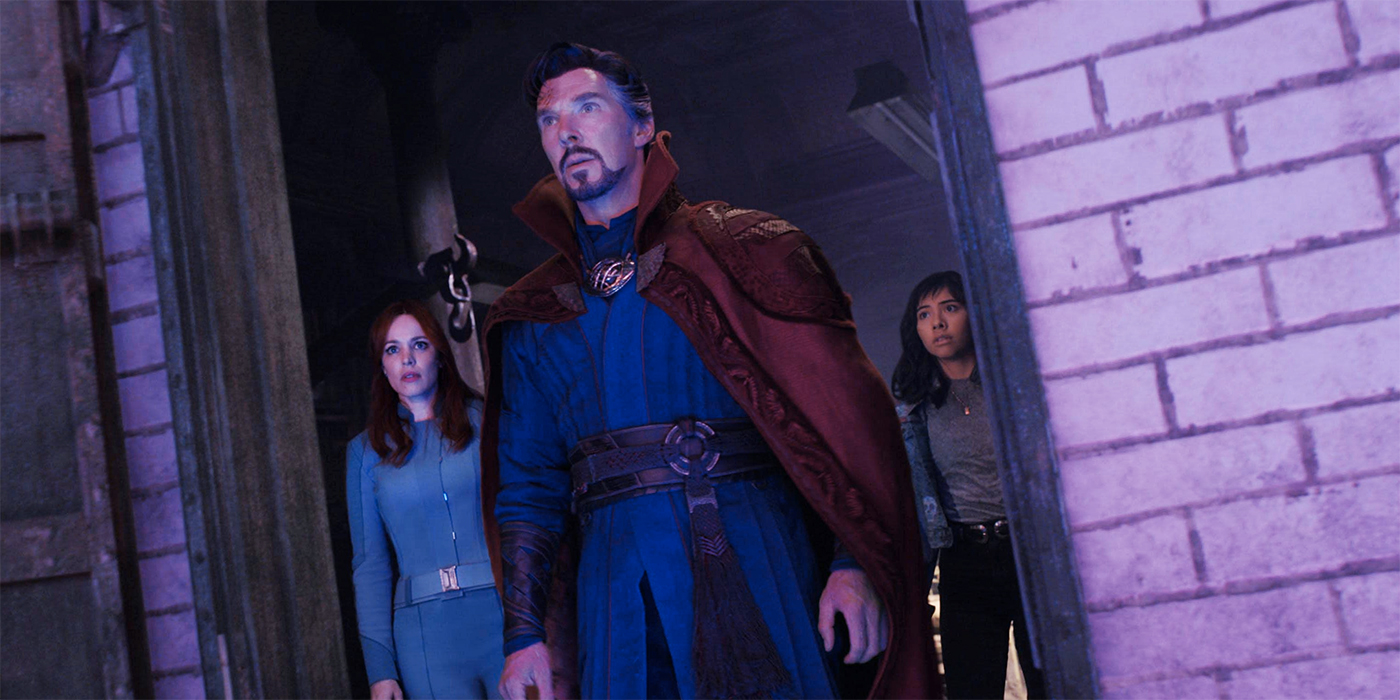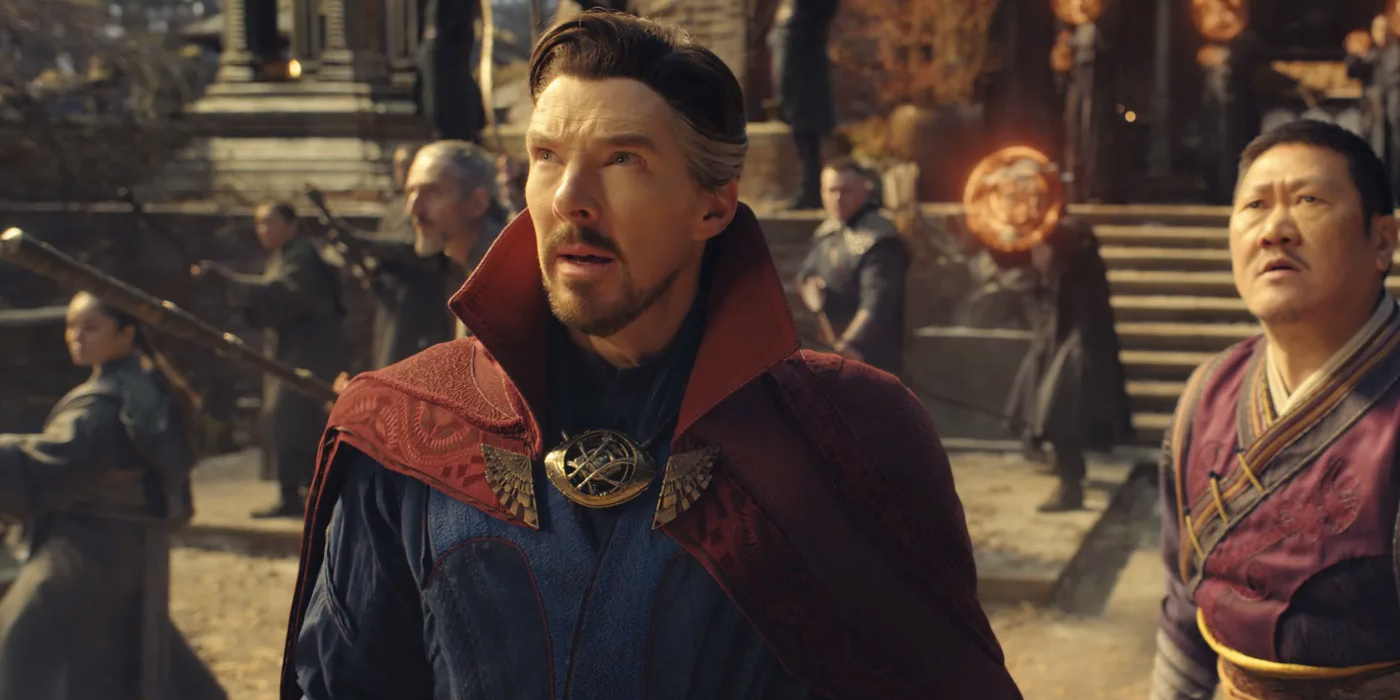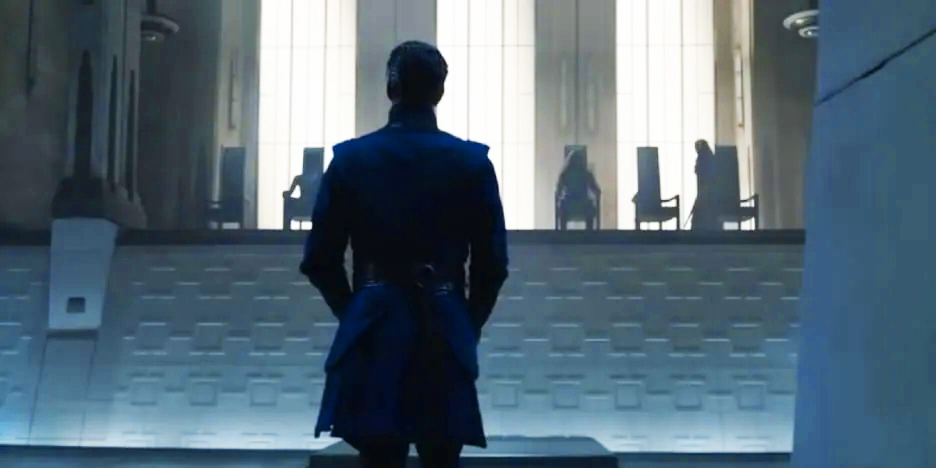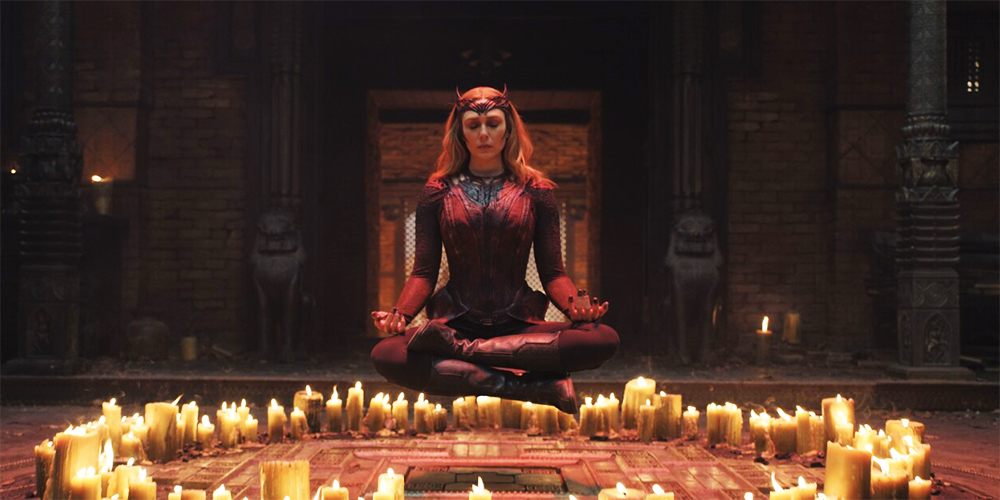After some time away from Doctor Strange in the Multiverse of Madness to think about it, and admittedly to edit multiple articles on the topic, it’s hard to recapture any of my initial excitement for this movie, before I saw it. As a critic, it can sometimes be hard to judge a movie fairly when the hype is big and the expectations are high. After the extremely mild reaction to Eternals (which this author did not hate nearly as much as others), Doctor Strange 2 signaled a welcome return.
Projects like Eternals, Shang-Chi, and Moon Knight have introduced new characters to the MCU, but none have been as rousing a success as Spider-Man: No Way Home, a movie that played not only on superhero nostalgia but tugged at our heartstrings while finishing up Spider-Man’s trilogy. Originally meant to be released after Multiverse of Madness and Loki, No Way Home told fans of the MCU that they hadn’t lost their touch. Doctor Strange 2 proves that that is not the case, even when it comes to revisiting a familiar hero.
The Sam Raimi-directed movie already had people clamoring with Raimi’s return to superhero movies. His Spider-Man trilogy is regarded highly by many fans, however, the third installment was heavily panned by audiences and critics. Known for his horror movies primarily, Raimi stands among the few directors of the MCU to truly put his stamp on a movie. Most films churned out by the Marvel machine have a sort of generic sheen to them. Few ever manage to truly stand out as far as direction goes. Guardians of the Galaxy, Thor: Ragnarok, and yes, even Eternals broke through those molds. Raimi’s Doctor Strange now joins their ranks.

Part of that is because of his true injection of horror into the MCU. It’s hard to find a movie that presses the boundaries of PG-13 quite as hard in Disney’s catalog, but I think exploding Black Bolt’s (Anson Mount) head and chopping Captain Carter (Hayley Atwell) in half takes the cake. But it’s not just the violence that makes it stand apart, it’s still not nearly as bloody as one might expect from someone who directed The Evil Dead, but it makes up for it in horror.
From Wanda (Elizabeth Olsen) crawling out of a mirror full on Ring style to her chasing down Stephen Strange (Benedict Cumberbatch), Christine (Rachel McAdams), and America (Xochitl Gomez) in an underground hallway, there are a surprising number of scares that might actually make people jump in their seats. It’s something I never considered Marvel would even try, given how family-friendly the brand has been, but this is definitely not the Marvel movie to take your kids to.
On top of all that, Danny Elfman’s score stands as the greatest winner of the movie. While some of the camerawork and cuts in Doctor Strange 2 can almost be dizzying or far too campy, Elfman is pitch-perfect. His score sets the perfect tone and at one point even works as the perfect accompaniment to a fight between two different Doctor Stranges. Plot-wise, it makes no sense why Doctor Strange, a character never before associated with music, would have such a musical battle, but I guess it was cool. Elfman, known infamously for working with Tim Burton as well as crafting classics like The Simpsons theme, must return to Marvel in some capacity in the future.

But, would it surprise you to hear that I actually left Doctor Strange in the Multiverse of Madness quite deflated? Coming in, my excitement was less for Raimi as director and more for Michael Waldron as the writer. Waldron penned and produced Disney+’s Loki, which stands as one of the best shows to come from the streamer yet. Full of emotional moments meshed with poignant character work, I had high expectations for Strange. And then, I watched the movie. The dialogue is almost unbelievably bad. Did someone ghostwrite this? Or was Loki really handled by a team of writers?
Not only is Waldron’s dialogue work painfully wooden, but Strange proves that Phase 4 of the MCU is as disjointed as ever. In a movie titled Multiverse of Madness about sorcerers and other universes, why is there not a single mention of any of the movies and stories that came before it? Would it have been so hard to casually mention of Shang-Chi‘s Ta Lo? Or throw Ned (Jacob Batalon) into the background next to America at the end? How about a mention of the events of Eternals? What about a cameo from Kang (Jonathan Majors) or the new Cap (Anthony Mackie)? It doesn’t all need to be in there, but where the MCU excelled at interconnectivity before, Phase 4 feels shattered.
Instead of trying to bring together some of the disparate parts, the movie spends the majority of its time offering up fan service. Yes, I know, it’s the MCU. Of course, there is going to be fan service. But not only did Marvel shoot themselves in the foot by giving away their biggest easter egg aka Professor X (Patrick Stewart), but was any of that Illuminati scene necessary? Cutting their entire scene from the movie doesn’t truly end up taking much away from the plot. Not only is the Illuminati ultimately unnecessary, but they are completely unhelpful.

The smartest man in the universe, Reed Richards (an immensely bland John Krasinski), handwaves the threat of Wanda Maximoff in favor of a handcuffed Stephen Strange. Lashana Lynch’s Maria Rambeau barely has any lines. Chiwetel Ejiofor’s Karl Mordo is suspicious to the point of stupidity. Black Bolt dies immediately. And Captain Carter can’t actually do this all day. The only stand out is Stewart’s Professor X, but that’s probably because the character is so familiar to him. His confrontation with Wanda is the most interesting part of the scene, even if it ends in his demise.
The entire movie is waterlogged by fanservice. After the initial shine of the Illuminati wears off and the rose-colored glasses are off, the scene is there to demonstrate one thing: Wanda is a vicious, brutal, heartless killer. Which leads to Strange‘s fatal mistake. Had the movie not pitted Wanda so firmly against Strange, I might have left this movie liking it as much as I liked anything else from Phase 4. But where Loki was masterful in its ability to introduce new concepts like the TVA and variants and characters like Sylvie, WandaVision was firing on all cylinders. Helmed by Jac Shaeffer, the first Disney+ series hit it out of the park when it came to storytelling and honing in on the heart of Wanda Maximoff’s character.
The series explored her immense grief after losing Vision, so strong that it created an entire magical prison called a Hex, where a town in New Jersey traveled through television history. Inside the Hex, she not only created a new version of Vision, one who was alive and married to her, but her own two children, Billy and Tommy. The Emmy award-winning series was Elizabeth Olsen at her finest playing Wanda. Exploring not only her desire to be a wife and mother but the trauma she suffered through when Sokovia was attacked and the mourning of the loss of her brother, Pietro.
So, what was the point of WandaVision? Because Doctor Strange rewrites history. The healing that Wanda experienced at the end of WandaVision when she finally said goodbye to Vision and was able to start recovering from her loss, is a scar that is ripped back open in this movie. But this time, Wanda is not someone mourning the death of a family. Now, Wanda is a Mother with a capital M. Erasing any nuance, any gentleness, Wanda, corrupted by the Darkhold, is not a killing machine. She doesn’t care about the loss of Vision. Now she is a mom and moms need their kids. Women, once mothers, are nothing else but mothers. They are not beings of their own, they are caretakers and protectors.

It’s a tremendously one-dimensional look at a character who had nine episodes of character growth. It turns one of the most powerful, complex Marvel characters into a one-note villain. Does Marvel have a villain problem? Yes, it seems, even when it turns a three-dimensional protagonist into the villain. It didn’t seem to have this problem with Loki, but I guess Loki wasn’t a mother. Doctor Strange loses brownie points by similarly making America Chavez essentially a macguffin and relegating Christine to the long-dreaded role of love interest/therapist.
As one of the most arrogant characters in the MCU, Stephen Strange was perhaps winning back some points with his performance in No Way Home. As a sort of reluctant parental figure to Peter (Tom Holland), he fulfilled a similar-but-not-the-same role as Tony. However, this almost exact relationship is played again in this movie with America, making the impact very little.
In the end, Marvel doubles down on “rules for thee, but not for me.” Wanda’s brush with the Darkhold turned her into a serial killer, a child murderer, and left her dead (for now). Stephen’s brush with the Darkhold gets him a third eye and a date with Charlize Theron. Not what I expected, but hey I also didn’t expect the Darkhold to get destroyed with the equivalent of a butter knife. If all it took was a sharp object penetrating the book, maybe Hawkeye would have been a better call? Even Tom Riddle’s diary needed a Basilisk fang.
When it comes to the problems with Doctor Strange in the Multiverse of Madness, it is multifaceted. On top of the problems I’ve mentioned, the expectations were just too high, especially coming off of Spider-Man. Marvel’s marketing team gave away far too much in their trailers, making us all think, if they are willing to give away that Professor X is in this, who else could be in it? Was this even really a sequel to Doctor Strange? No, it really wasn’t. If anything it was a bastardized sequel to WandaVision, one that leaves anyone who loves Wanda jaded and disappointed. I’m sure Doctor Strange will be perfect for some eager to see Raimi’s return, but it is an insult to the most powerful being in Marvel, cutting her off at the legs and weighing her down with a misogynist trope.
Very well put! While I might have overall enjoyed it more can’t argue or deny the points made here! Especially in regards to Wanda, Strange and the Darkhold. That stinger continues the time honored tradition of marvel movies making sure you’re never worried that the characters are truly going to be reckoning with any lasting trouble. It seems like a scary cliffhanger, gets resolved (or at least is suggested as fine) 3 minutes later.
Completely disagree with the idea that the film feels ‘shattered’ from the rest of the MCU. You named very specific cameos that didn’t really need to be there. The new captain America would have absolutely no place in MOM, and neither would Kang. One of the most annoying criticisms of this film are the countless cameos people expected. You cannot have an entire film revolving around the cameos specific people wanted in it. You get what you’re given. In regards to referencing other films/marvel projects, Marvel’s ‘What If’ was referenced multiple times, most notably the inclusion of Captain Carter, and the evil Dr Stranger universe was also clearly a nod to ‘What If’. Not to mention the whole context of Wanda’s change to becoming a villain was entirely reliant on context from Wandavision. Including mentions through cameos, this film overlaps with 8 other marvel projects.